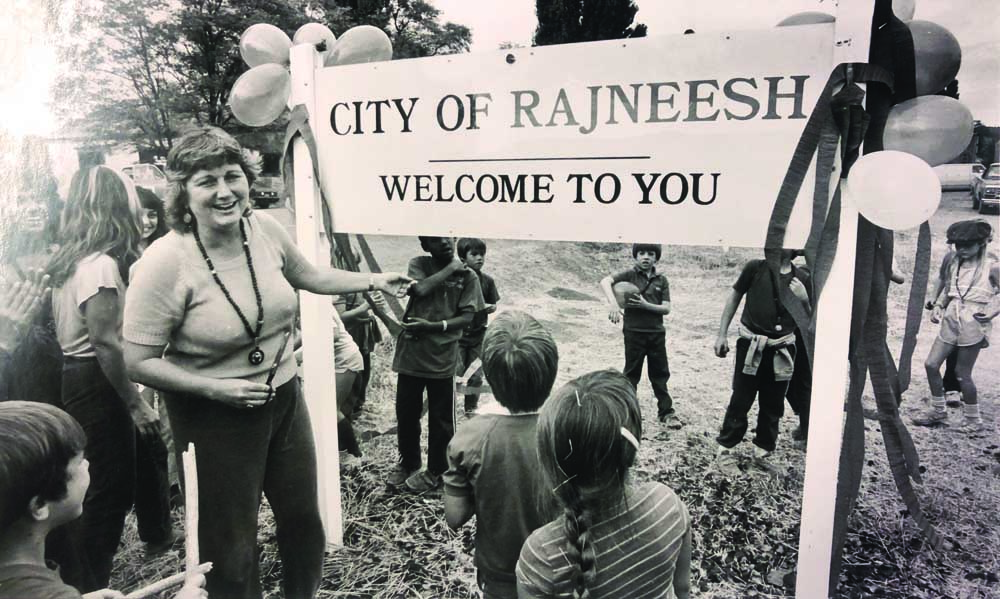New High Desert Museum exhibit focuses on intentional communities, utopias
Published 3:45 pm Wednesday, January 26, 2022

- Citizens of Rajneeshpuram welcomed visitors to Wasco County in the early 1980s before collapsing in 1985.
As long as the West has symbolized freedom and second chances, people — idealistic, finished with the status quo, in search of something new — have been creating intentional communities here.
Communities such as the Kaweah Co-Operative Colony, a socialist utopia of central California in the late 1800s, have proliferated in the High Desert and other regions of the West.
“Imagine a World,” a fascinating new exhibition opening Saturday at the High Desert Museum, looks at the past 50-plus years of such colonies and their utopian bliss, hippie communion, religious and other forms of freedom.
There are dome domiciles and biospheres and more. It also includes that Oregon intentional community whose infamy proceeds it, the Rajneeshpuram, which drew adherents of the Rajneesh movement and its guru Bhagwan Shree Rajneesh, to Wasco County in the early ’80s. An era Rolls Royce is included among the items, offering one more picture of the Rajneeshee community.
“Imagine a World” is divided into five sections, starting with the Rajneeshpuram and followed by artistic communes, ecological laboratories, Indigenous futurisms art by Native artists and, finally, a space where visitors are invited to imagine their own communities.
Included in the exhibition are some 1960s and ’70s communes — such as a still-in-existence hippie outpost known as the Hog Farm, co-founded by Wavy Gravy, and Colorado collective Drop City, which gathered under R. Buckminster Fuller’s geodesic dome concepts. They built their domes out of salvaged materials, at least until Drop City ceased to be in 1973.
“We have another set of communities we’re looking at that we’ve been thinking of as ecological laboratories,” said Laura Ferguson, the High Desert Museum’s senior curator of Western history and the curator of “Imagine a World.”
“Folks were looking at other ways to live that are more sustainable and in harmony with the landscape.”
Among these is the extant Earthship Biotecture, a nonprofit organization with a community in New Mexico involved in sustainable architecture.
“They build homes called ‘Earthships,’ and in many ways, they do have a community in New Mexico, but also the Earthships exist around the globe,” Ferguson said. “In many ways, it’s not just a physical community, but it’s also this shared commitment and culture and ethos.”
Also included in “Imagine a World” are Arcosanti, an experimental town in the Arizona High Desert north of Phoenix begun in 1970, and Biosphere 2, an Arizona research facility that was created as a closed ecological system and now serves as a university research facility.
The exhibition also includes futurist concepts envisioned by Indigenous artists Frank Buffalo Hyde, Camas Logue and Brutis Baez. The artists are part of a movement known as Indigenous futurisms, the imagining of Native people into the future, including in science fiction, literature, video games and more. Their works envision “alternative worlds and recognize the ways that cosmology, science and futurism have long been part of Indigenous worldviews and oral traditions,” according to the High Desert Museum.
“The thing I’m really excited about with this exhibition is that it’s asking a lot of questions, and my hope is that it’s really going to spark curiosity and conversation among visitors,” Ferguson said. “I think that, in so many ways right now, we continue to be in the midst of the COVID pandemic, and that it’s shaped our lives in so many ways. It’s really prompted these questions about who we are and who we want to be as individuals and a society. And I think it’s really highlighted the importance of community.”
What: “Imagine a World,” an exhibition on intentional and utopian communities throughout the West
When: Opens Saturday and displays through Sept. 25
Where: High Desert Museum, 59800 S. Highway 97, Bend
Cost: Free with museum admission
Contact: highdesertmuseum.org or 541-382-4754






